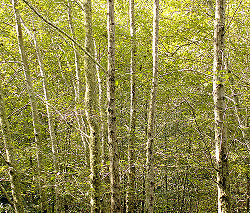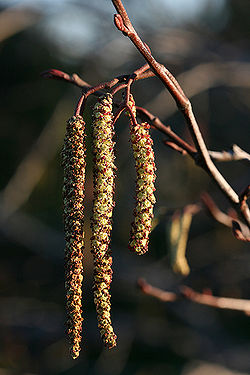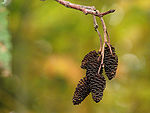Red alder
| Red alder |
|---|

|
| Scientific Classification |
|
| Binomial Name |
|
Alnus rubra |
| Image Description |
The Red alder is a species of Alder known by the scientific name Alnus Rubra. It is one of the biggest trees in the world and also the biggest among all of the alders. The alder like all trees play vital parts in our world. We would not be around with out them. the oxygenate the world and provide us with resources for us to use in our every day life’s along with giving homes and shelters to the wild life around us.
Anatomy
The Red Alder is the largest alder and one of the largest trees in the world at heights of 20 - 35 m. there is a bright rusty red color that forms on scratched or broken off bark. The bark most of the time is a ashy gray smooth color with moss hanging all over it [1]. The leaves are an oval shape 7cm long with rough edges. The leaves turn yellow before they fall for autumn. The male flowers of the tree are reddish and are 10 -17 cm long and the hang from the branches. The female catkins turn into a woody pin cone 2-3cm long. The seeds bloom in the autumn.
Reproduction
Most red alder reach maturity at ages 3-4. The red alder produces what are called catkins. There are male and female catkins. The female catkins are pine cone looking. The male catkins are greenish and reddish and long pointing downwards. They get anywhere between one and three inches long. Most flowering occurs in the late winter to early spring. The seeds to the red alder are nuts born in pairs. Most of the seeds are released in late fall early winter.
Ecology
Red Alders are normally located in the northern pacific. It can be found anywhere between the low lands of southern California to the lowlands of Alaska [2]. They are normally found near the ocean. They grow anywhere between the temperatures of -22 degrees to 115 degrees. They like soils any where from well drained soils to not so well drained soils. They like sand and clays however they are not normally found in clays but more moist soils that are in marshes and so forth. They are able to withstand certain flooding conditions and some droughts depending on how bad. Alders like most plants use photosynthesis as there food source. They absorb light and turn it into food using photosynthesis. Alders turn carbon dioxide into oxygen which re oxygenates the world.
Uses
Red Alder has many uses. Its dense wood makes it easy and good for making hard wood things like furniture. It is also used for composite things like plywood. Alders are used for a fuel wood in many fireplaces and mills for drying. Its rapid growth ability makes it easy to use by farmers for energy conversion. They also help raise the nitrogen levels in the soil around them and lower the ph in the soil.
Gallery
References



